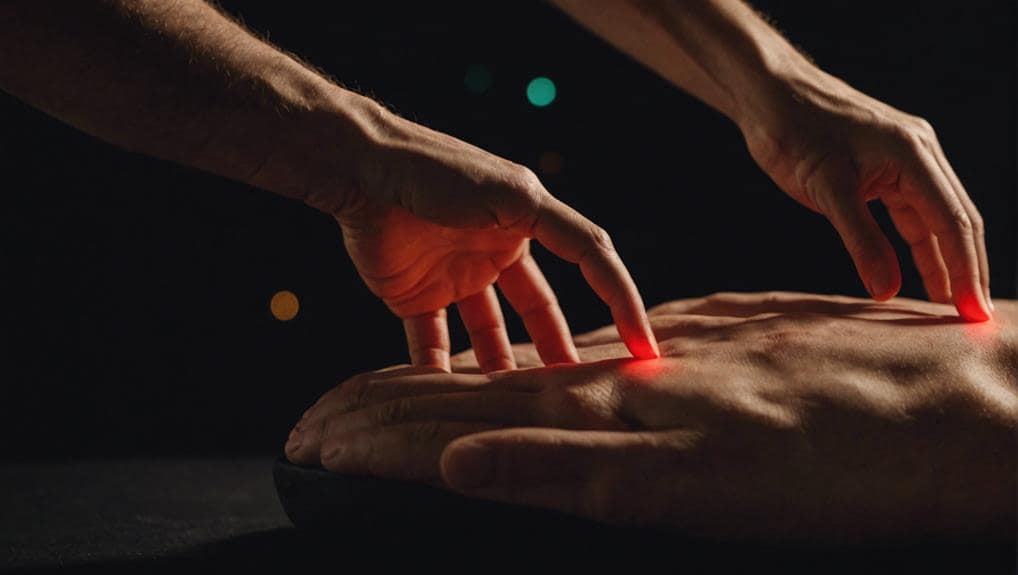When it comes to self-defense, knowing the top 3 pressure points can give you a powerful advantage in a dangerous situation. Imagine being able to swiftly immobilize an assailant using just a well-placed strike. Picture the element of surprise as you target these strategic points on the body. You'll want to learn more about how to effectively utilize these pressure points for protecting yourself and potentially saving the day.
Key Pressure Points to Target
In order to effectively defend yourself using pressure points, it's important to know the key areas to target on the human body.
The first critical pressure point is located at the base of the neck where it meets the shoulder. Striking this point can cause immense pain and temporary paralysis, giving you a chance to escape from an attacker.
The second significant pressure point is found on the wrist, right at the joint where it meets the hand. Applying pressure here can help you break free from a grip or control hold.
Lastly, the third important pressure point is situated on the upper lip, just under the nose. A forceful strike to this area can disorient your attacker, allowing you to create distance and seek help.
Effective Techniques for Self-Defense
To effectively defend yourself using pressure points, mastering specific techniques is crucial for your self-defense arsenal. Here are a few effective techniques to help you protect yourself in dangerous situations.
Firstly, the eye gouge technique can be extremely powerful. In a threatening situation, aim to strike the attacker's eyes using your fingers or thumbs forcefully. This can cause immense pain and temporarily blind the assailant, providing you a chance to escape.
Secondly, the nose strike technique is another valuable move. By utilizing the palm of your hand or your elbow, aim to strike the attacker's nose upwards. This can cause immense pain, disorienting the assailant, and potentially even break their nose, creating an opportunity for you to flee.
Lastly, the temple strike technique is effective for disorienting your attacker. By delivering a sharp blow with your palm or fist to the temple area on the side of the head, you can cause dizziness and confusion, allowing you to create distance and seek help.
Quick Strikes for Maximum Impact
Mastering quick strikes is essential for achieving maximum impact in self-defense situations. When facing a threat, swift and precise strikes can create opportunities to escape or neutralize the aggressor effectively. The key is to focus on vulnerable areas such as the eyes, nose, throat, groin, and knees.
In a high-stress situation, simplicity is key. Aim for quick jabs at the eyes or a powerful strike at the throat to incapacitate your attacker. Remember, the goal is to create enough of a distraction to give yourself a chance to get away safely.
Practice these techniques regularly to build muscle memory and increase your speed and accuracy. Combining speed along with proper technique can greatly boost the impact of your strikes.
In self-defense, every second counts. By honing your ability to deliver rapid and forceful strikes, you can effectively defend yourself in dangerous situations. Stay focused, stay prepared, and always prioritize your safety above all else.
Frequently Asked Questions
Can Pressure Points Be Used for Non-Violent Self-Defense?
Yes, pressure points can be used for non-violent self-defense. By applying strategic pressure to certain points on the body, you can control an attacker without causing harm. Proper training is crucial for effective use.
Are Pressure Points Effective Against Multiple Attackers?
When facing multiple attackers, pressure points can be effective for self-defense. Focus on areas like the eyes, throat, and groin to disorient and incapacitate opponents swiftly. Training in these techniques improves your ability for protecting yourself.
Do Pressure Points Work on All Body Types?
Yes, pressure points can be effective on various body types. Understanding the anatomy and applying techniques correctly is key. By practicing, you can develop the skill to use pressure points for self-defense regardless of body type.
Can Pressure Points Cause Long-Term Damage?
Yes, pressure points can potentially cause long-term damage if applied incorrectly or with excessive force. Understanding proper technique and exercising caution is essential to avoid unintended harm when targeting pressure points in self-defense situations.
Are Pressure Points Legal to Use in Self-Defense?
Yes, pressure points are legal to use in self-defense as long as you are in imminent danger and acting in self-defense. Remember, proper training is vital to make sure you use them effectively and responsibly.
Conclusion
Remember, in a self-defense situation, targeting the top 3 pressure points can help you defend yourself effectively. By striking the base of the neck, wrist joint, and upper lip using precision and force, you can disorient and incapacitate your attacker, creating an opportunity to escape and seek help.
Practice these techniques regularly to build confidence and readiness in case of an emergency. Stay safe and stay prepared.

